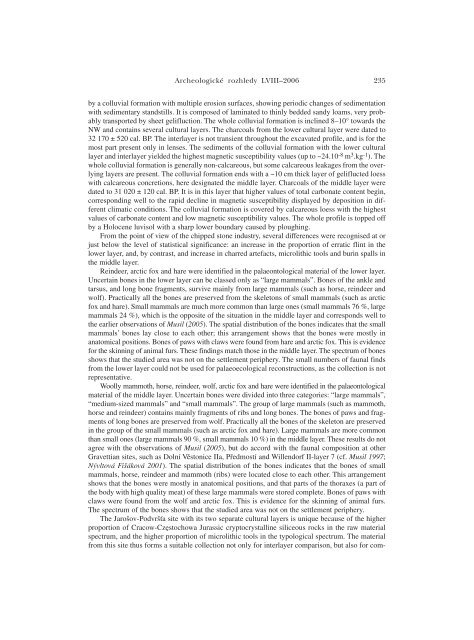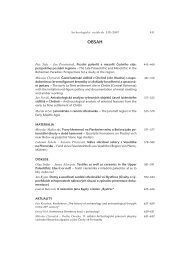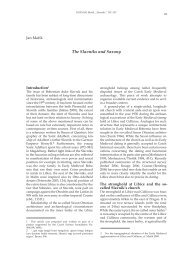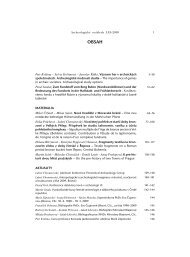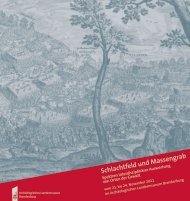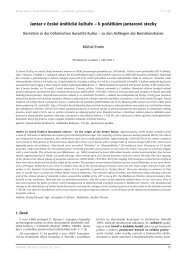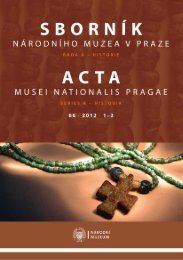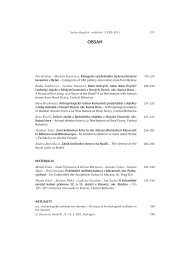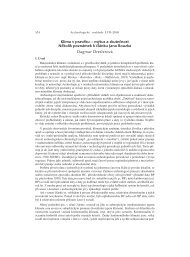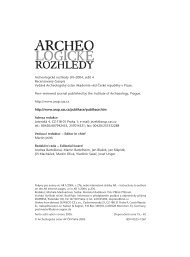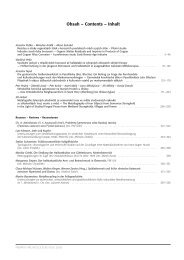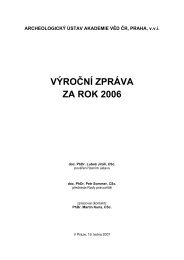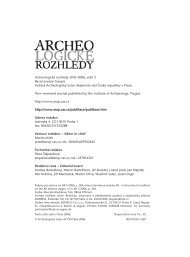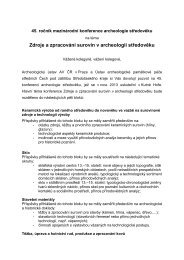Archeologické rozhledy 2006 - Archeologický ústav AV ČR
Archeologické rozhledy 2006 - Archeologický ústav AV ČR
Archeologické rozhledy 2006 - Archeologický ústav AV ČR
Create successful ePaper yourself
Turn your PDF publications into a flip-book with our unique Google optimized e-Paper software.
<strong>Archeologické</strong> <strong>rozhledy</strong> LVIII–<strong>2006</strong> 235by a colluvial formation with multiple erosion surfaces, showing periodic changes of sedimentationwith sedimentary standstills. It is composed of laminated to thinly bedded sandy loams, very probablytransported by sheet gelifluction. The whole colluvial formation is inclined 8–10° towards theNW and contains several cultural layers. The charcoals from the lower cultural layer were dated to32 170 ± 520 cal. BP. The interlayer is not transient throughout the excavated profile, and is for themost part present only in lenses. The sediments of the colluvial formation with the lower culturallayer and interlayer yielded the highest magnetic susceptibility values (up to ~24.10 -8 m 3 .kg -1 ). Thewhole colluvial formation is generally non-calcareous, but some calcareous leakages from the overlyinglayers are present. The colluvial formation ends with a ~10 cm thick layer of geliflucted loesswith calcareous concretions, here designated the middle layer. Charcoals of the middle layer weredated to 31 020 ± 120 cal. BP. It is in this layer that higher values of total carbonate content begin,corresponding well to the rapid decline in magnetic susceptibility displayed by deposition in differentclimatic conditions. The colluvial formation is covered by calcareous loess with the highestvalues of carbonate content and low magnetic susceptibility values. The whole profile is topped offby a Holocene luvisol with a sharp lower boundary caused by ploughing.From the point of view of the chipped stone industry, several differences were recognised at orjust below the level of statistical significance: an increase in the proportion of erratic flint in thelower layer, and, by contrast, and increase in charred artefacts, microlithic tools and burin spalls inthe middle layer.Reindeer, arctic fox and hare were identified in the palaeontological material of the lower layer.Uncertain bones in the lower layer can be classed only as “large mammals”. Bones of the ankle andtarsus, and long bone fragments, survive mainly from large mammals (such as horse, reindeer andwolf). Practically all the bones are preserved from the skeletons of small mammals (such as arcticfox and hare). Small mammals are much more common than large ones (small mammals 76 %, largemammals 24 %), which is the opposite of the situation in the middle layer and corresponds well tothe earlier observations of Musil (2005). The spatial distribution of the bones indicates that the smallmammals’ bones lay close to each other; this arrangement shows that the bones were mostly inanatomical positions. Bones of paws with claws were found from hare and arctic fox. This is evidencefor the skinning of animal furs. These findings match those in the middle layer. The spectrum of bonesshows that the studied area was not on the settlement periphery. The small numbers of faunal findsfrom the lower layer could not be used for palaeoecological reconstructions, as the collection is notrepresentative.Woolly mammoth, horse, reindeer, wolf, arctic fox and hare were identified in the palaeontologicalmaterial of the middle layer. Uncertain bones were divided into three categories: “large mammals”,“medium-sized mammals” and “small mammals”. The group of large mammals (such as mammoth,horse and reindeer) contains mainly fragments of ribs and long bones. The bones of paws and fragmentsof long bones are preserved from wolf. Practically all the bones of the skeleton are preservedin the group of the small mammals (such as arctic fox and hare). Large mammals are more commonthan small ones (large mammals 90 %, small mammals 10 %) in the middle layer. These results do notagree with the observations of Musil (2005), but do accord with the faunal composition at otherGravettian sites, such as Dolní Věstonice IIa, Předmostí and Willendorf II-layer 7 (cf. Musil 1997;Nývltová Fišáková 2001). The spatial distribution of the bones indicates that the bones of smallmammals, horse, reindeer and mammoth (ribs) were located close to each other. This arrangementshows that the bones were mostly in anatomical positions, and that parts of the thoraxes (a part ofthe body with high quality meat) of these large mammals were stored complete. Bones of paws withclaws were found from the wolf and arctic fox. This is evidence for the skinning of animal furs.The spectrum of the bones shows that the studied area was not on the settlement periphery.The Jarošov-Podvršťa site with its two separate cultural layers is unique because of the higherproportion of Cracow-Częstochowa Jurassic cryptocrystalline siliceous rocks in the raw materialspectrum, and the higher proportion of microlithic tools in the typological spectrum. The materialfrom this site thus forms a suitable collection not only for interlayer comparison, but also for com-


